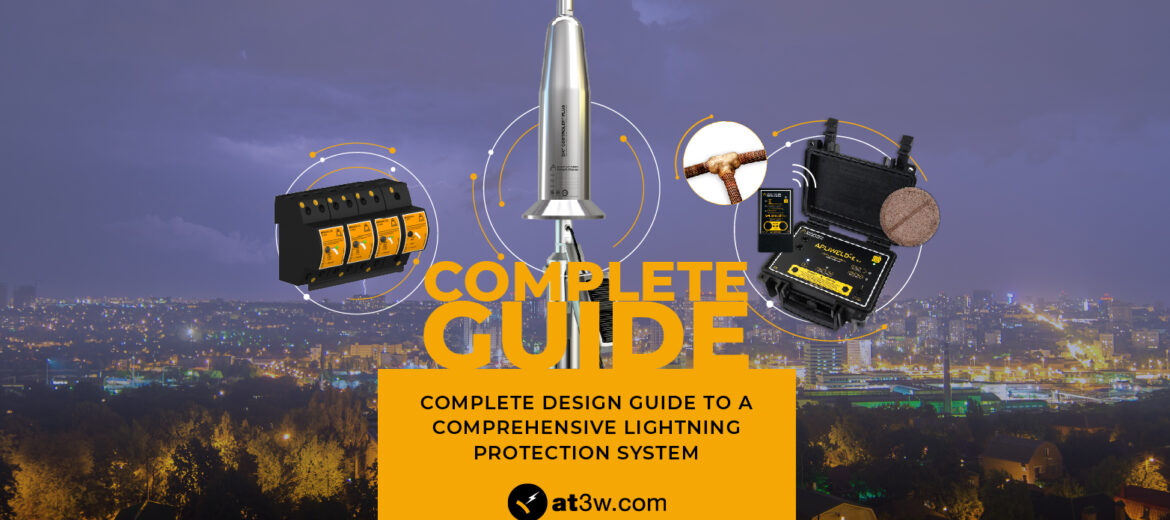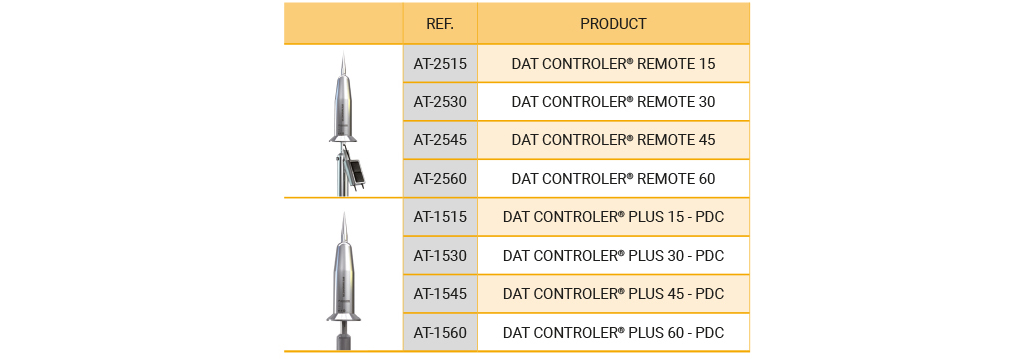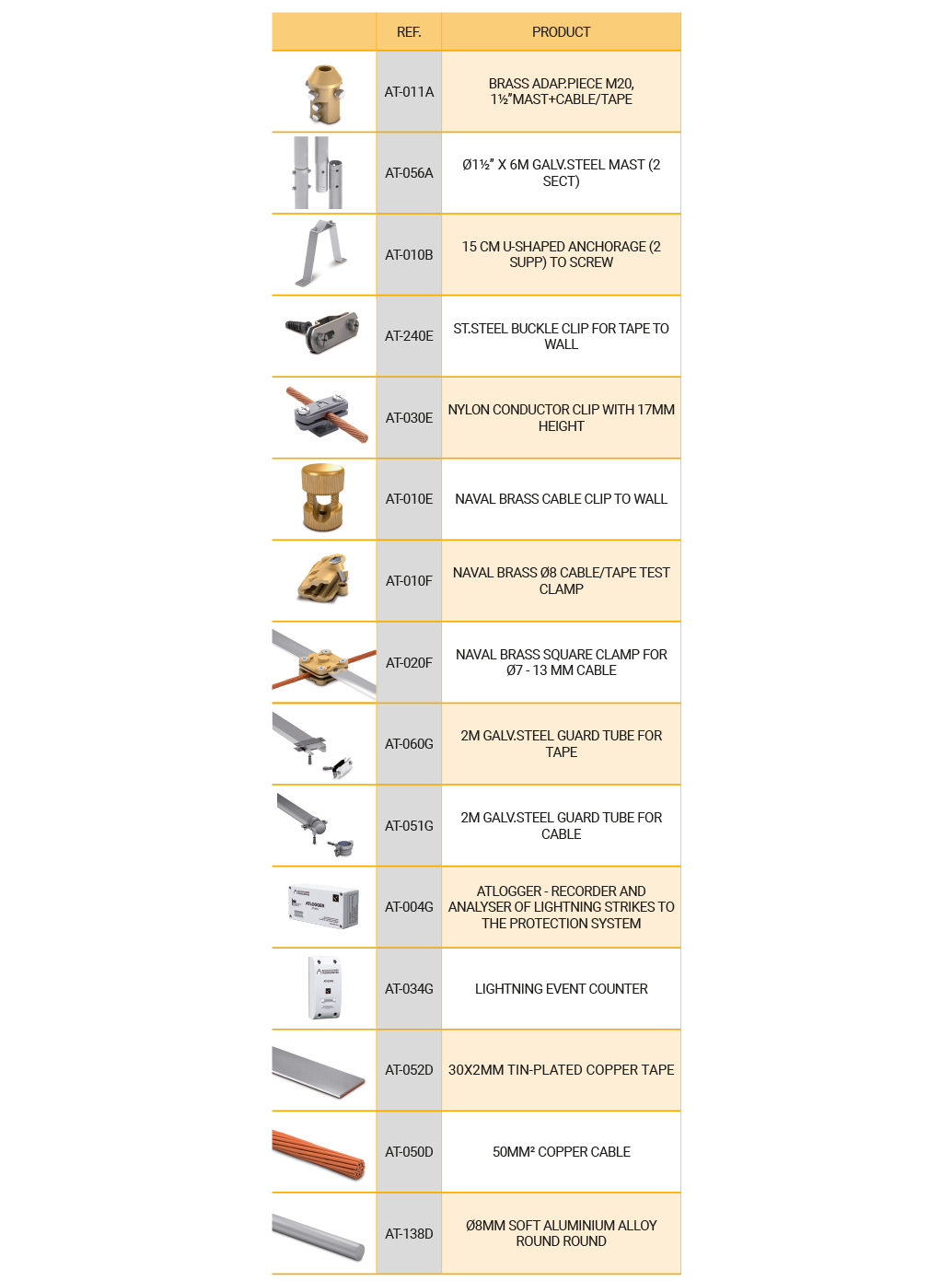Lightning is one of nature’s most destructive events, so it is essential to protect people, the environment and infrastructures from its effects, as well as guaranteeing the continuity of services and safeguarding material and cultural assets. The purpose of a lightning protection system is to capture lightning, conduct its current safely to earth, dissipate in the ground and protect against the secondary effects of lightning.
The lightning protection standards define procedures for calculating the risk index of a structure to determine the required installation of a lightning protection system (LPS) and the level of protection it should provide.
The lightning protection level of a LPS considers both the lightning current parameters and the probability of not exceeding the maximum and minimum design values in the event of a thunderstorm. These maximum and minimum values are used for the dimensioning of the LPS elements (thickness of the metal sheets, current capacity of the surge arresters, separation distances against dangerous sparks), for the test parameters and for the positioning of the LPS sensors.
The following is a guide to design a comprehensive lightning protection system, based on Aplicaciones Tecnológicas S.A.’s recommended products.
External lightning protection system
An external lightning protection system consists of one or more lightning rod ends, two or more down conductors and an earthing system.
Interception: DAT CONTROLER® Air terminal
Early Streamer Emission (ESE) air terminals are characterised by continuously emitting an upward tracer to intercept the downward lightning tracer before any other element within its protection radius. An ESE device with a longer lead time in the formation of the upward tracer (more time in advance of the ignition), captures the downward tracer at a greater distance, protecting a larger area. The protection radius of a lightning rod for each height is calculated with the advance time of the lightning rod and the level of protection against lightning (Technical Building Code, CTE; the UNE 21186 standard; NF C 17-102 and NP 4426).


Level IV is the least restrictive, which means that, although it intercepts high current lightning, it may not capture low current lightning. Level I considers more restrictive and safer conditions for the sensors, thus allowing interception of associated lower current lightning strikes. It must also be able to withstand the effects of high energy lightning.
The DAT CONTROLER® air terminals of Aplicaciones Tecnológicas S.A. are equipped with the latest technology in ESE devices. In addition, the smart air terminal DAT CONTROLER® REMOTE has self-diagnosis of the head and communication via IoT of the result to ensure the correct operation of the equipment.
Down-conductors and accessories
At Aplicaciones Tecnológicas S.A. we have all the necessary accessories for the down-conductors, as well as masts for the ESEand other parts. Among the accessories we highlight the lightning strike counters, as they are useful tools to determine if there has been a lightning strike in the installation. In addition, the smart meter ATLOGGER REMOTE monitors the electrical activity in the down-conductor, characterises the lightning strikes and uses IoT communication to transmit the data in real time.
Earthing
The earthing system is an indispensable element of the external lightning protection system, responsible for dispersing the lightning current into the ground. The correct functioning of the earthing system depends on the conductivity of the ground. This conductivity is mainly electrolytic in nature due to the salts dispersed in the water that permeates it. It can therefore be increased by improving the water absorption and retention capacity and increasing the concentration of soluble salts.
The APLIROD® dynamic electrode gradually reduces the resistivity of the surrounding soil by supplying free ions. APLIROD® absorbs the ambient humidity to diffuse into the surrounding soil.
We also have the conductivity ground enhancing gel, CONDUCTIVER PLUS. It contains an electrolytic base that increases conductivity and water absorption and retention capacity. It is a gel that is not very soluble and very hygroscopic, especially recommended for stony soils.
In high resistivity soils or industries that require a low earthing resistance (such as computer installation earthing, radiofrequency equipment, transformation centres, etc.), APLICEM conductive cement is capable of increasing the conductive surface of the electrode, maintaining it indefinitely.
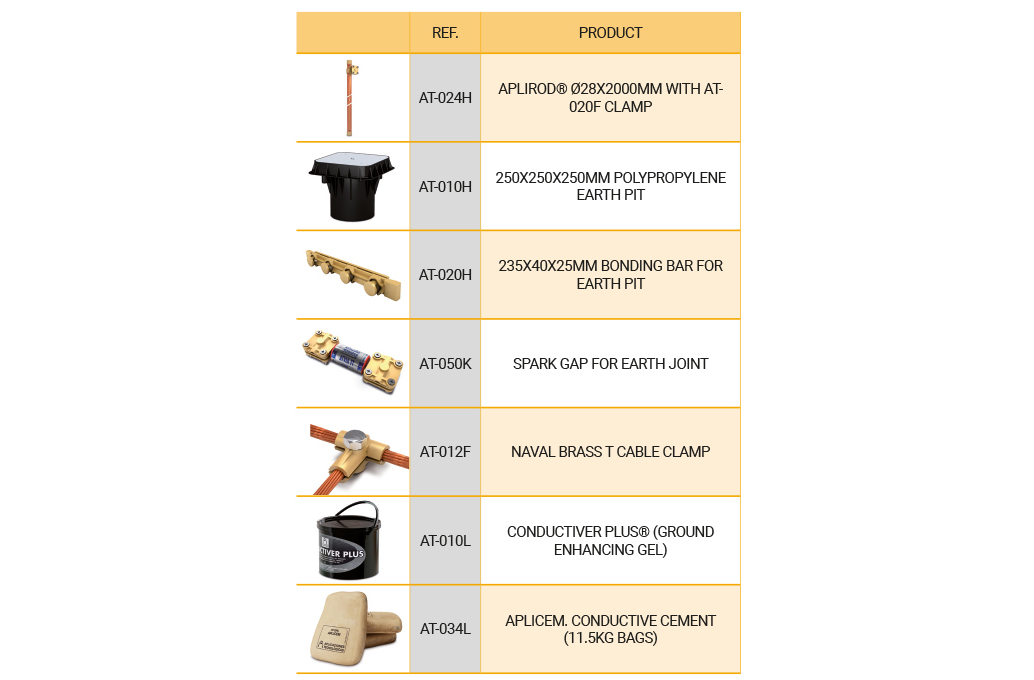
In addition, exothermic or aluminothermic welding is recommended for the interconnection of conductors, as the molecular bonds guarantee an effective and durable earthing. With its innovative tablet format, electronic initiators and remote ignition, APLIWELD® Secure+ is the most efficient and safest exothermic welding solution on the market. Various moulds, clamps and accessories are available in our catalogue.
Internal lightning protection system
An internal lightning protection system must have an adequate overvoltage protection installation as well as other measures to minimise the destructive effects of lightning (equipotential bonding, shielding, etc.).
Although transient overvoltages can have different origins, the most destructive are caused by lightning. These very short-lived voltage surges are introduced into equipment via power, telephone, television or data supply lines. Overvoltage protection maintains continuity of service by reducing the likelihood of safety incidents to an acceptable level for people and property. Surge protection devices are characterised by being inactive when the electrical signal is normal, but respond instantaneously to transient surge peaks, conducting the lightning current to earth and protecting equipment. Once the surge is absorbed, the DPS returns to its idle state. The types of overvoltage are as follows:
- Type 1: protect against the effects of direct lightning strike and are therefore installed in places where lightning currents and electromagnetic effects of lightning are not attenuated (main switchboards).
- Type 2: protect against the secondary effects of lightning, in places where lightning currents and electromagnetic effects are already attenuated (secondary frames).
- Type 3: protect against overvoltages that are already very damped, leaving very low residual voltages. They are installed close to the equipment to be protected.


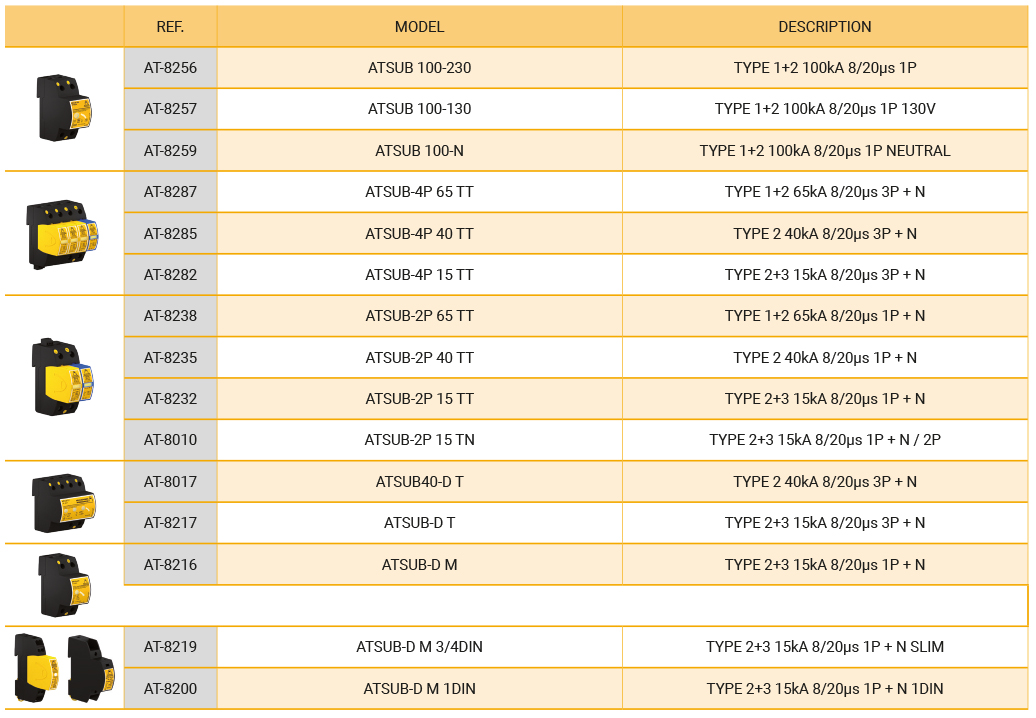 The protection of power supply lines can be carried out with overvoltage protectors of the ATSHOCK, ATSHIELD, ATSUB, ATCOVER and ATCOMPACT series of Aplicaciones Tecnológicas S.A. The ATSHOCK protectors are type 1 and must be used in combination with the ATSUB and/or ATCOVER series. The ATSHIELD series are type 1+2 protectors, which absorb direct lightning current leaving low residual voltages. The ATSUB series has 1+2, 2 and 2+3 protectors. The ATCOVER surge protectors are of type 2+3. On the other hand, the ATCOMPACT series allows all the above protectors to be combined within an already wired cabinet, which is particularly useful in distribution boards without sufficient space.
The protection of power supply lines can be carried out with overvoltage protectors of the ATSHOCK, ATSHIELD, ATSUB, ATCOVER and ATCOMPACT series of Aplicaciones Tecnológicas S.A. The ATSHOCK protectors are type 1 and must be used in combination with the ATSUB and/or ATCOVER series. The ATSHIELD series are type 1+2 protectors, which absorb direct lightning current leaving low residual voltages. The ATSUB series has 1+2, 2 and 2+3 protectors. The ATCOVER surge protectors are of type 2+3. On the other hand, the ATCOMPACT series allows all the above protectors to be combined within an already wired cabinet, which is particularly useful in distribution boards without sufficient space.

 On a more specific level, the ATPV series is designed and adapted for the protection of photovoltaic panels, while the ATVOLT series protects DC power lines.
On a more specific level, the ATPV series is designed and adapted for the protection of photovoltaic panels, while the ATVOLT series protects DC power lines.
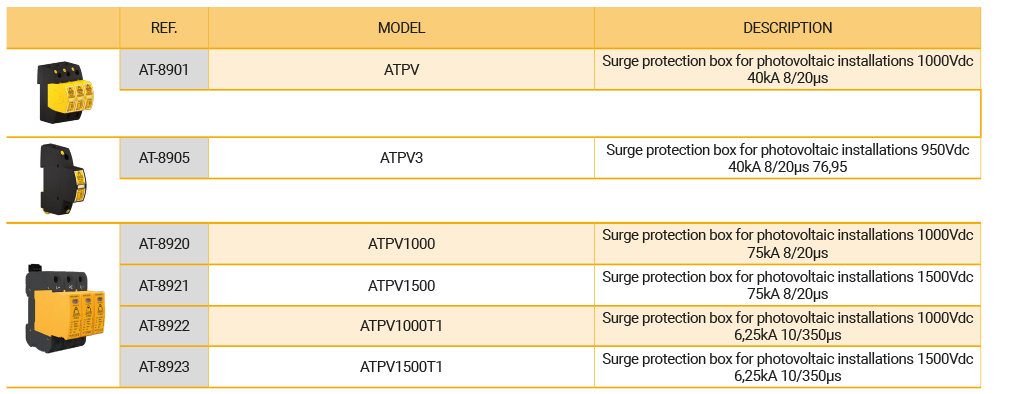
 Aplicaciones Tecnológicas S.A.’s type 3 protectors include the ATSOCKET (internal power supply installations) and ATPLUG (for power supply line sockets) series. In addition, the ATFONO (analogue telephone lines, ADSL, ISDN), ATLINE, ATLAN (computer lines and internal computer network RJ45), ATDB9 (DB9 type data lines) and ATFREQ (coaxial cables) series are available for the protection of telecommunication and data lines.
Aplicaciones Tecnológicas S.A.’s type 3 protectors include the ATSOCKET (internal power supply installations) and ATPLUG (for power supply line sockets) series. In addition, the ATFONO (analogue telephone lines, ADSL, ISDN), ATLINE, ATLAN (computer lines and internal computer network RJ45), ATDB9 (DB9 type data lines) and ATFREQ (coaxial cables) series are available for the protection of telecommunication and data lines.
Permanent overvoltages protectors
Although permanent overvoltages are not caused by lightning, their effects are just as destructive, so Aplicaciones Tecnológicas S.A. has specific protectors against them, as well as combined protectors against transient and permanent overvoltages. Permanent overvoltages are caused by defects or breakage of the neutral, or by faults in the transformer substations.
Our permanent surge protectors belong to two families: IGA TEST and ATCONTROL. Both families have series of protectors exclusively against permanent overvoltages and combined protectors against permanent and transient overvoltages. The main difference between the IGA TEST and ATCONTROL families is that the former incorporates a cut-off element that disconnects the line when it detects a permanent overvoltage.
The IGA TEST COMPACT series are compact modules with type 2 permanent and transient overvoltage protection. The IGA TEST SUB surge arresters consist of an IGA TEST surge arrester against permanent overvoltage and an ATSUB type 2 surge arrester against transient overvoltage. In the IGA TEST SUB 1 series, the ATSUB surge arrester is of type 1+2.



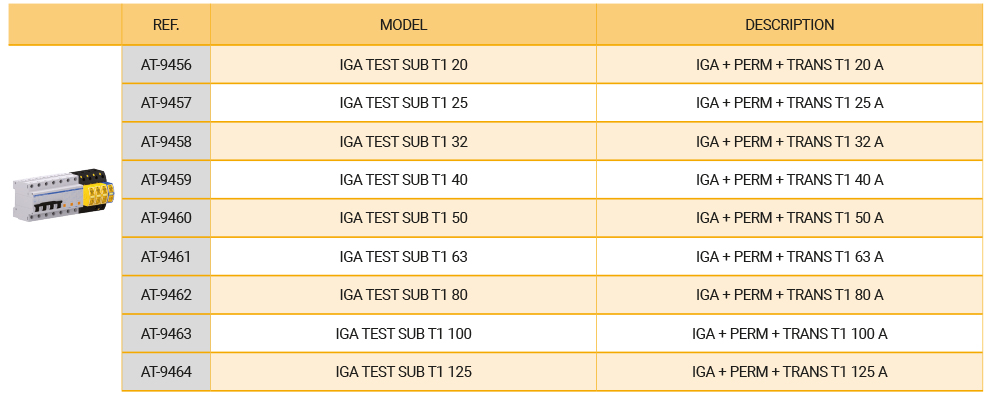
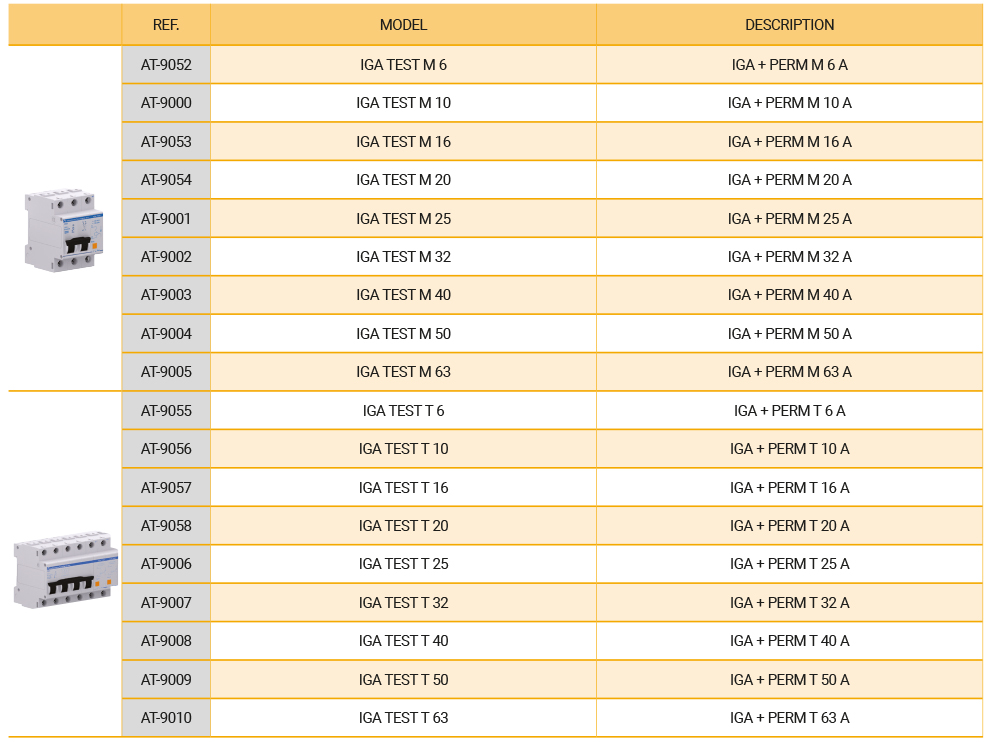
 IGA TEST D surge protectors have the IGA circuit breaker with a slower tripping curve (D-curve). They are recommended for high consumption buildings (offices, hotels, schools or clinics) where an IGA TEST protector could disconnect the line without a permanent overvoltage having occurred.
IGA TEST D surge protectors have the IGA circuit breaker with a slower tripping curve (D-curve). They are recommended for high consumption buildings (offices, hotels, schools or clinics) where an IGA TEST protector could disconnect the line without a permanent overvoltage having occurred.
Unlike the IGA TEST family, ATCONTROL protectors can be coupled to other breaking elements: the /B version acts on an emission relay coil associated with a MCB (manual reclosing) while the /R option acts on a contactor (automatic reclosing capability). All the protectors in the ATCONTROL/R series protect against overvoltage and undervoltage. In the case of ATCONTROL/B, the ATCONTROL/B PLUS series would be required. The ATCONTROL family does not include the cut-off elements, except for ATCONTROL/R COMPACT (which contains a contactor in the protector itself), and the kits: the ATCONTROL/B KIT, ATCONTROL/B PLUS KIT, ATCONTROL/B D KIT (incorporating a circuit breaker).




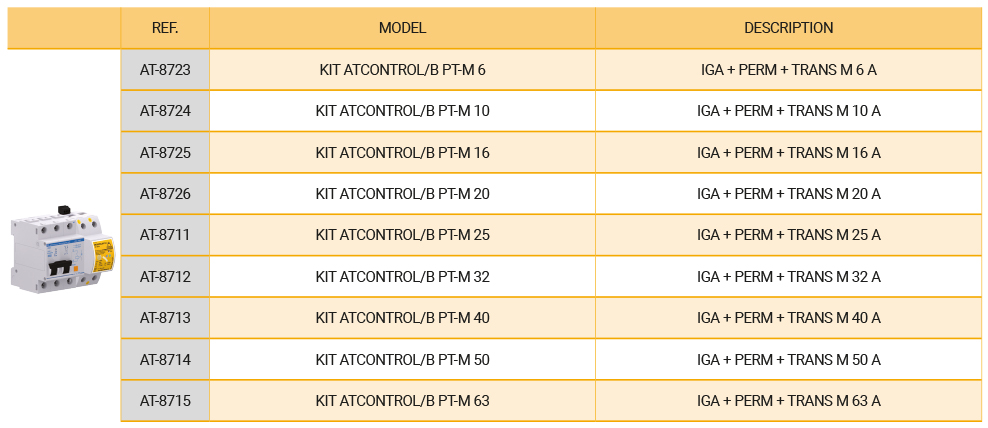


 ATPLUG CONTROL is a plug-in surge arrester that protects against permanent and transient overvoltages and undervoltages of type 3.
ATPLUG CONTROL is a plug-in surge arrester that protects against permanent and transient overvoltages and undervoltages of type 3.
In addition, line tester is available which monitors three-phase mains voltages, mains frequency and earth impedance.

 Aplicaciones Tecnológicas S.A. offers the most advanced technologies and materials for the design of a complete lightning protection system. If you would like more information about our products, you can contact our experts at the following link.
Aplicaciones Tecnológicas S.A. offers the most advanced technologies and materials for the design of a complete lightning protection system. If you would like more information about our products, you can contact our experts at the following link.
